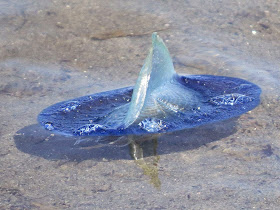For more than a month now, Pacific
Northwest outer ocean beaches have been the scene of a massive stranding of
by-the-wind sailors, Velella velella.
These little blue critters are washing up on our beaches by the billions. Each
time a new high tide comes in, they are deposited at the upper end of the
waves in windrows on the beach.
Velella wrecks are commonplace on the
Pacific coast, usually happening in the spring of most years. But this year has
produced a bumper crop of them, many more than usual, from Vancouver Island to
California. First noticed in August of 2014, they came in in stupendous numbers
in the spring of 2015 with unusually strong onshore winds. They are everywhere
in tropical and temperate oceans, but their strandings seem to be most common
on the American Pacific coast.
Velella is a colonial animal, each
sailor made up of hydroids attached together under a chitinous float, the individuals thought to be specialized for prey capture, digestion and reproduction. A
stiff semicircular sail projects upward from the float, so any breeze blows the
sailor across the surface. The sail is set at a bit of a diagonal, so the Velella is actually tacking off the downwind
direction. It is speculated that the direction of tacking is such that the
animals are kept offshore for the most part, but changing winds can undo that safety factor.
One
of the most characteristic things about Velella
is its beautiful blue color. The blue pigment is apparently a protection
against harmful ultraviolet radiation from the sun that streams down through
the day.
Velella are typical cnidarians,
possessing nematocysts in their tentacles that kill tiny planktonic prey,
including crustacean larvae and fish eggs, and digest them in a central stomach
area. This nutrition is shared among the individuals and is augmented by algae (zooxanthellae) in the colony that photosynthesize and produce organic carbon and nitrogen. In the class Hydrozoa,
they are more closely related to hydras than to jellyfish, although not as
closely related to Portuguese man-o’-war as previously believed.
They
feature alternation of generations, reproducing like typical members of the
phylum Cnidaria. The sailors that we see bud off tiny medusae (“jellyfish”)
that then produce male and female gametes that fuse and form larvae that at
some point presumably assemble into the animals that we see. Exactly how this
happens is still quite unknown, and the smallest ones that are usually seen are
fully developed.
You
might guess that Velella, just
because of its abundance, would be attractive as prey, yet much of the animal
is inedible chitin, the same protein that makes up the exoskeleton of insects.
Their best-known predators are spectacular pelagic nudibranchs (Glaucus) and a group
of unusual snails (Janthina) called
violet snails that produce mucus with their foot that forms into bubbles that
support them. They float on the surface darkside up, countershaded like oceanic
fish!
Two
jellyfish predators, ocean sunfish (Mola
mola) and leatherback turtle (Dermochelys
coriacea), are said also to consume Velella,
but there seems little evidence for this. Many sandpipers fed among the Velella
at Grays Harbor recently, and some poked into the tentacles, perhaps finding
small prey among them.
These
Velella velella are not to be
mistaken for the Seattle musical group of the same name!
Dennis Paulson





